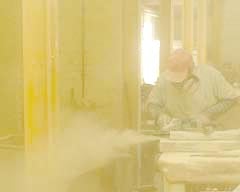Breathe the word 'cancer' softly – Safety & Health at Work Week, 22-28 October
Granite, sandstone, slate. They contain a lot of silica. Engineered quartz has even more. Fine silica particles in the air get into your lungs and they stay there… growing… turning your lungs to concrete, so you can't breathe. In the end cancer develops and your life is cut short.
Yet dust in stone processing workshops seems so innocuous. Lots of people working in the industry breathe silica dust every day. That is something you might want to think about during Safety & Health at Work Week, 22-28 October.
Every year, 8,000 people in the UK die because of exposure to carcinogens at work and 13,500 new occupational cancer cases are registered (source: HSE).
Throughout the EU, approximately 120,000 people develop cancer annually as a result of their work activities.
The construction industry accounts for the largest number of occupational cancer cases, with approximately 3,500 cancer deaths and 5,500 new cancer registrations each year in Britain.
Silica is not the only culprit. Exposure to asbestos is the leading cause of death from occupational cancer today. Exposure to diesel engine exhaust emissions, to the sun from working outside with skin unprotected, welding fumes, even shift working can be causes of occupational cancer.
The 2018 European Week for Safety & Health at Work promotes the prevention of risks posed by dangerous substances in the workplace. This is a key event in the two-year Healthy Workplaces Manage Dangerous Substances campaign being run by the European Agency for Safety & Health at Work (EU-OSHA) and supported by the British Safety Council. The aim is to reduce the presence of and exposure to dangerous substances in workplaces by raising awareness of their risks and promoting effective ways of managing them.
Christa Sedlatschek, Executive Director of EU-OSHA, says: "Protecting workers from exposure to carcinogens is one of the key challenges for occupational safety and health in the 21st century."
"We are working to highlight the scale of the problem and the importance of preventing exposure to carcinogens at work as part of our current campaign. We believe that by informing and educating workers and employers, as well as offering practical solutions, we can reduce and even eliminate exposure to carcinogens at work, thereby preventing needless suffering and deaths from cancer.”
David Parr, Policy & Technical Services Director at the British Safety Council, adds: “Although use of some of the most dangerous substances, such as asbestos, are now banned or strictly controlled, modern workplaces continue to expose workers to dangerous agents, such as highly toxic liquids and chemicals, as well as nanomaterials, the health risks of which are not yet fully understood but are predicted to be even greater.
“The most effective way of managing exposure to dangerous substances in the workplace is the creation of a risk prevention culture. When this happens, workers are pro-actively involved in risk assessment processes and are well informed about the dangers, as well as the control measures that can be taken to prevent or control them."
Occupational exposure limits (OELs) for hazardous substances laid down in health & safety directives play a major role in protecting people and with Brexit imminent, David Parr says: "It is essential that the well-established control regime relating to this issue is not compromised in any way by the UK's withdrawal process."

